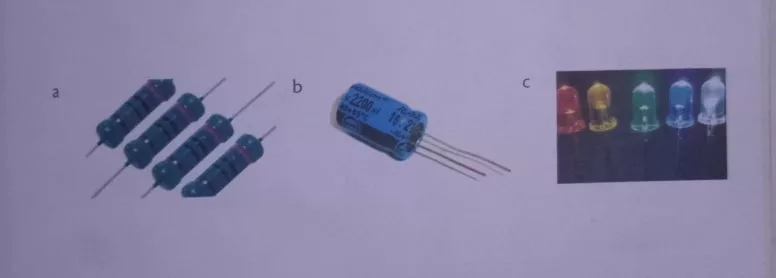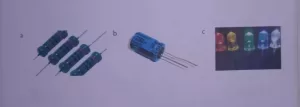Integrated Science Questions by Topics | Electronics, ecosystem, atmosphere and climate change and infections and diseases

Integrated science questions by topics
Integrated Science Questions by Topics | Electronics, ecosystem, atmosphere and climate change and infections and diseases
Learners must be examined after every integrated science topic. These integrated science questions by topics are questions that have been collated to help teachers evaluate learners.
Unit: Electronics
Part 1: Objectives
Integrated science questions by topics
1. Which of the following devices opposes the flow of a current in a d.c electronic circuit
a. LED b. capacitor c. resistor d. inductor
2. Which of the following is an application of a semi-conductor
a. resistor b. inductor c. capacitor d. light emitting diode
Part 2: Written
Integrated science questions by topics
3. What is the role of the following discrete electronic components in an electronic circuit
a. capacitor b. light emitting diode
4. Draw a diagram to illustrate a 6 V a.c source connected in series with a key capacitor and light emitting diode
5. Identify the following electronic components

Unit: Ecosystem
Part 1: Objectives
Integrated science questions by topics
1. The ………………. is the part of the earth in which life exists. It includes the land, water, and air/ atmosphere
a. biosphere b. habitat c. niche d. community
2. A network of food chains is known as a. community b. biosphere c. food web d. trophic level
3. The scientific study of interactions among organisms and their environment is
a. biosphere b. ecology c. community d. trophic level
4. ……… are organisms that break down and obtain energy from dead organic matter
a. producers b. decomposers c. autotrophs d. herbivores
5. The biological influences of organisms within an ecosystem are called
a. biotic factors b. abiotic factors c. nonrenewable resources d. biomes
6. An organism that obtains energy by eating animals is known as
a. carnivore b. herbivore c. producer d. dentritivore
7. Temperature, light, air, water, soil, and climate are all ……………. parts of the environment
a. biotic b. abiotic c. boreal d. living
8. What is an ecosystem?
9. a. Explain the following ecological terms: environment, population and community
10. Use the following organisms:
green grass, lizard, locust, butterfly, frog, tiger, and antelope to construct
i. a food chain ii. a food web
Unit: Atmosphere and climate change | Integrated science questions by topics
Part 1: Objective
1. All the following are greenhouse gases except
a. carbon (IV) oxide b. methane c. water vapor d. carbon (II) oxide
2. Which of the following would have the biggest impact on reducing carbon emissions?
a. growing our own vegetables b. stopping deforestation
c. taking all fossil-fuel burning vehicles off the road d. Shutting down all fossil fuel power plants
3. The second layer of the atmosphere is the
a. troposphere b. stratosphere c. mesosphere d. ionosphere
Part 2: Written
Integrated science questions by topics
4. Differentiate between the troposphere and stratosphere in terms of the following: temperature, air, composition and pressure
5. Outline five effects of climate change on biodiversity resources
6. Mention two effects of the supersonic air transport on the ozone layer
7. Mention two examples of acidic pollutants and how they affect forests and buildings
8. a. What is acid rain
b. What are the four main gasses of greenhouse?
9. a. What is the full meaning of CFCs?
b. Explain how CFCs deplete the ozone layer
10. a. Define global warming
b. Discuss three effects of global warming on the environment
Unit: Infections and diseases
Part 1: Objective
Integrated science questions by topics
1. Which of the following diseases is caused by protozoa?
a. rabies b. small pox c. tetanus d. malaria
2. One of these diseases affects both livestock and humans
a. anthrax b. heatwater c. chicken pox d. measles
3. A disease which is likely to make a child a cripple is
a. tuberculosis b. choleria c. poliomyelitis d. malaria
4. Insect pest that carry pathogens to transmit diseases are called
a. parasites b. vectors c. bites d. infectors
Part 2: Written
Integrated science questions by topics
5. Which of the following is a non-pathogenic disease due to nutrient deficiency?
a. colour blindness b. sickle cell c. whooping cough d. kwashiorkor
6. i. Briefly explain what is meant by sexually transmitted infection
ii. State the causative agent of the following sexually transmitted infections
a. AIDs b. Gonorrhoea c. Syphilis
7. i. What is pathogen?
ii. State four ways in which human body defends itself against pathogens
8. Outline the effects of diseases in your community
Post Disclaimer
The information contained in this post is for general information purposes only. The information is provided by Educative News and while we endeavour to keep the information up to date and correct, we make no representations or warranties of any kind, express or implied, about the completeness, accuracy, reliability, suitability or availability with respect to the website or the information, products, services, or related graphics contained on the post for any purpose.








